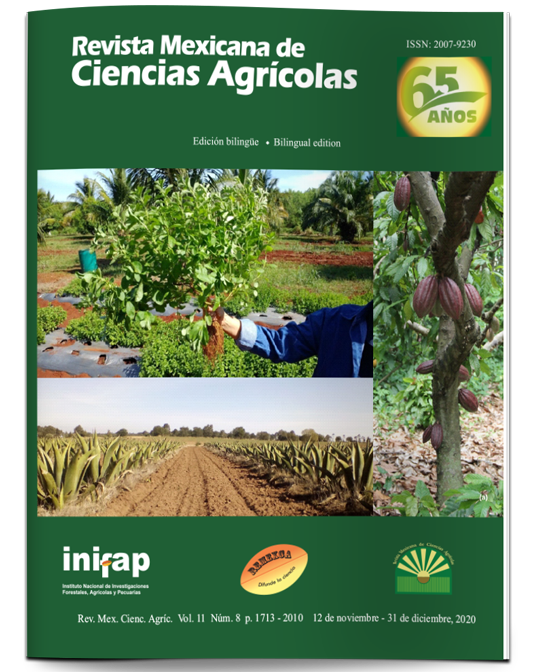Phenotypic variability of Phytophthora capsici isolates in Guanajuato
DOI:
https://doi.org/10.29312/remexca.v11i8.2618Keywords:
pepper wilt, population diversity, sensitivity to mefenoxamAbstract
Phytophthora capsici, is the causal agent of ‘pepper wilt’, one of the most important diseases of this crop. To establish efficient control strategies, it is necessary to know the diversity of the pathogen, for this, this research was carried out whose objective was to determine the degree of variability of 29 monozoosporic isolates obtained from pepper (Capsicum annuum L.) from six municipalities of the state of Guanajuato and two reference strains of A1 and A2. All were characterized by growth form, type of compatibility, growth at 35 °C, sensitivity to mefenoxam, and degree of virulence. The results obtained indicate that the isolates presented 5 forms of growth: stellate (62.5%), turulous (15.62%), stoloniferous (12.5%), filamentous (6.25%) and petaloid (3.12%); its growth at 35 °C was less than 30.7% compared to the control grown at 27 °C, its compatibility type was 65.5% of the A1 type, intermediate sensitivity to mefenoxam was found in 65.5% of the isolates, the rest being sensitive. The most virulent isolate was D3 and the avirulent ones were D8, D11 and D12, all from Dolores Hidalgo. There is no direct relationship between growth form, growth at 35 °C, type of compatibility, resistance to mefenoxam, and degree of virulence.
Downloads
Published
How to Cite
Issue
Section
License
Copyright (c) 2020 Revista Mexicana de Ciencias Agrícolas

This work is licensed under a Creative Commons Attribution-NonCommercial 4.0 International License.
The authors who publish in Revista Mexicana de Ciencias Agrícolas accept the following conditions:
In accordance with copyright laws, Revista Mexicana de Ciencias Agrícolas recognizes and respects the authors’ moral right and ownership of property rights which will be transferred to the journal for dissemination in open access. Invariably, all the authors have to sign a letter of transfer of property rights and of originality of the article to Instituto Nacional de Investigaciones Forestales, Agrícolas y Pecuarias (INIFAP) [National Institute of Forestry, Agricultural and Livestock Research]. The author(s) must pay a fee for the reception of articles before proceeding to editorial review.
All the texts published by Revista Mexicana de Ciencias Agrícolas —with no exception— are distributed under a Creative Commons License Attribution-NonCommercial 4.0 International (CC BY-NC 4.0), which allows third parties to use the publication as long as the work’s authorship and its first publication in this journal are mentioned.
The author(s) can enter into independent and additional contractual agreements for the nonexclusive distribution of the version of the article published in Revista Mexicana de Ciencias Agrícolas (for example include it into an institutional repository or publish it in a book) as long as it is clearly and explicitly indicated that the work was published for the first time in Revista Mexicana de Ciencias Agrícolas.
For all the above, the authors shall send the Letter-transfer of Property Rights for the first publication duly filled in and signed by the author(s). This form must be sent as a PDF file to: revista_atm@yahoo.com.mx; cienciasagricola@inifap.gob.mx; remexca2017@gmail.
This work is licensed under a Creative Commons Attribution-Noncommercial 4.0 International license.



